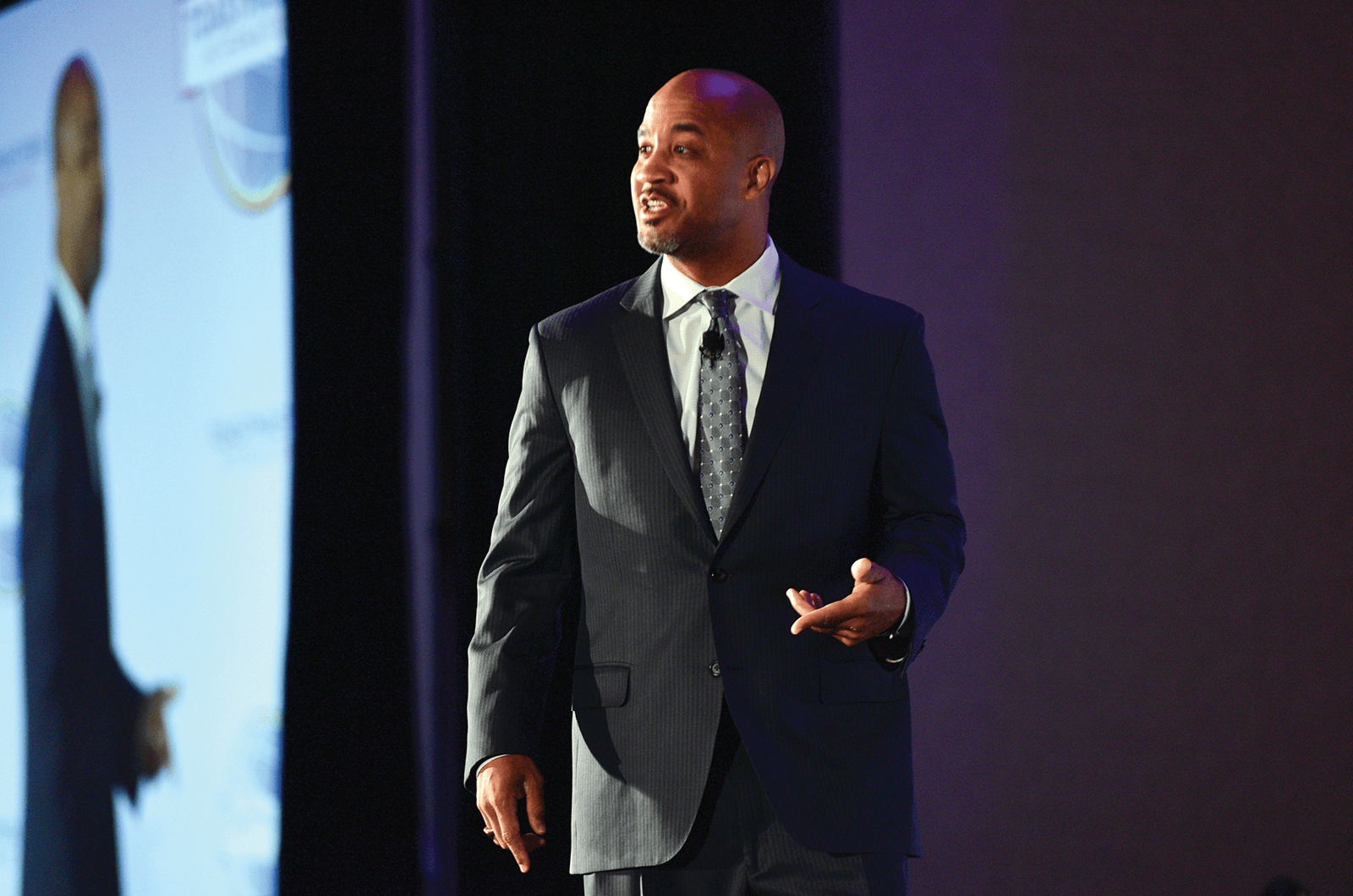
Over the past 20 years, I’ve had some amazing opportunities to speak to audiences about the importance of leadership and presentation skills, and I’ve been fortunate to touch lives around the globe. The main tool I’ve used to accomplish this is storytelling. Storytelling helps both leaders and presenters motivate, inspire, and influence their listeners. It also helps them be remembered.
Here are 15 storytelling techniques I use that can help you breathe life into your speeches and keep your audiences on the edge of their seats.
1 Use a “foundational phrase.”
For each story, develop a foundational phrase your audience can easily remember and repeat. It should be simple to say, audience focused, and preferably fewer than 10 words. For example, one of my foundational phrases is, “Don’t get ready, stay ready.” It sticks with my audience.
2 Don’t start each story from the beginning.
You can start from the middle or even the end. For example, I could start like this: “There I was, standing on stage with the 1st place trophy at the World Championship of Public Speaking. It was surreal! However, it didn’t start out that way. In fact, four years earlier…” You can start at the end and work back to how you got there. Mix it up with each story.
3 Get to your stories quicker.
There’s way too much set-up (what I call “pre-ramble”) for many stories. Get to the story and then go rapidly into the conflict and hook your audience.
4 Don’t be the guru of your own story.
The guru is the person who gives you the advice that helps you overcome your conflict and changes your life for the better.
The longer you work on a story, the shorter it should get.
I share a story of how I wanted to leave the company I worked for in order to live my dream of being a professional speaker. The vice president kept offering to raise my salary so I would stay. When I asked my wife what I should do, she said, “I don’t care how much they try to compensate you. Your dream is not for sale.” I left and spoke more than 160 times in one year. My wife is the guru of that story. Having a guru helps you remain similar, rather than special, to your audience.
5 Pause and look.
Realize it’s the look you give before, during, and after the line that really tells the story. The story lives in the spaces between the lines. Don’t rush into your next line. Many of my laughs come from the looks rather than the lines. Therefore, the structure of your speech must allow enough space for you to take your time. Remember, you can’t rush and resonate.
6 Don’t just establish a conflict, escalate it.
Think of it like the Titanic. Hitting the iceberg established the conflict but then what happened? The water started rising on the Titanic. That escalation of the conflict led to a desperate need for a solution. You should show how your conflict escalates too. For example, I share a story about wanting to write a book on the art of public speaking. My friends said it would never work because it would be too hard to find a publisher. The more negativity they gave me, the more the conflict escalated. Finally, my friend Steve called and said, “Craig, if you write that book, I’ll be the first one in line to purchase it.” After a deep sigh of relief, I said, “Steve, that’ll be 15.95.”
7 Invite your audience into your scene.
For example, I say, “Imagine being in my passenger’s seat as I went through the drive-through.” My audience members are now in my passenger’s seat where they can relive the story with me.
8 Condense to connect
When you deliver a scene with characters having dialogue, don’t tell us everything, just tell us the main thing. Try not to go back and forth between characters more than a few times, because your audience will grow tired. Instead, put the important statements in those few lines of dialogue.
9 Come out of your story and talk to your audience.
Remember, you’re not doing a stage play. You’re having a conversation with your audience. When you get into a story, you don’t have to lose that conversation. For example, I may say:
You should have been with my wife and me 15 years ago when we took our six-month-old daughter, Tori, to the doctor. Raise your hand if you have kids. Great, then you know the doctor is going to measure her length and…? They yell out, Her weight!
On a side note, I often hear someone answer, “Her height!” At that point I say, “You do know that the length, when you turn her upright, becomes the height, right?”
Even though I already started my story, I still looked out into the audience and asked them about their kids. I call this a “you-focused check-in.” It keeps the audience on their toes because, instead of being passive spectators, they become active participants.
10 Make your audience curious from the beginning
What questions can you plant in their minds that they’ll want answered during the story? I start one story with, “The best leadership principle I ever learned was from the president of the United States in the early 1990s when I shared a golf cart with him.” My audience likely has one of the following questions:
- Which president?
- How did you get to be in a golf cart with him?
- What is the lesson he taught?
Because of the curiosity, my audience anticipates coming on the journey with me. Tease them before you tell them.
11 Don’t keep repeating your message
When your story is over and you’ve given your foundational phrase (that short phrase that is easy to remember and repeat), don’t ramble on about the point. The story actually makes the point, and the foundational phrase makes the point memorable. If you keep talking and trying to drive the point home, your audience will want the ride to end.
12 Create characters.
When delivering the lines of your characters, use their posture, positioning, and maybe a slight change in your voice to make that person come alive and be different from the other characters. You might have a character that is stern, has a very stiff posture, and crosses his arms and frowns when he talks. Become that character.
Remember, you’re not doing a stage play. You’re having a conversation with your audience.
13 Show the emotional change in your character.
After you overcome or transcend your conflict, make sure your audience recognizes the transformation. If there’s no change there’s no story.
14 Be subtle with most of what you do delivery-wise.
For example, you don’t need to speak with a child’s voice when delivering the lines of a child. Instead, speak with your voice (with maybe a slightly higher pitch) but deliver it with the child’s expression. You can also have him or her look up to show that the child is talking to an adult.
15 With a few exceptions, keep your stories short.
The longer you work on a story, the shorter it should get. It’s addition by subtraction. The story gets better not by what you put in but by what you remove. I try to keep mine under four minutes so I can leave my audience wanting more.
Using these 15 storytelling tips will help you touch lives around the globe and become the speaker others sign up and line up to see.
Craig Valentine is the 1999 World Champion of Public Speaking. He is an internationally known professional speaker, author, and speech coach and is the founder of the Speak and Prosper Academy. Learn more at www.52speakingtips.com.



 Previous
Previous
 Previous Article
Previous Article

